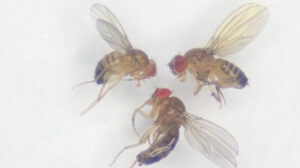Posted on December 12, 2023 in ASRC News, Neuroscience Initiative

Sleepless fruit flies recover lost sleep over multiple cycles, similarly to people, and serotonin was found to play a role in the process.
We’ve all experienced that sense of pervasive sleepiness after staying up late or sleeping poorly. That sense of drowsiness, our body’s way of telling us to recover lost sleep, is thanks to sleep homeostasis, a physiological mechanism that works to regulate sleep. When this process is thrown off balance, the homeostat kicks into high gear.
This is especially true when with a deprivation of deep sleep, which is crucial for brain plasticity, immune system function, healthy metabolism, and learning.
But sleep researchers at the Advanced Science Research Center at the Graduate Center (CUNY ASRC) say the common fruit fly, Drosophila melanogaster, can help shed light on the functions of deep sleep. In a new paper, published in the journal eLife, the neuroscientists found that when deprived of deep sleep, the fly attempted to recover it over the course of multiple sleep cycles.
And crucially, they discovered the neurotransmitter serotonin was tracking the recovery process.
Paying it back
During experiments, the flies were woken up before they entered the deep sleep cycle, said first author Budhaditya Chowdhury, a postdoctoral research associate at the CUNY ASRC.
“One of the first things that we found was that when you nudge flies awake as they fall asleep, they don’t pay back all the lost sleep immediately, they pay it back over multiple cycles,” Chowdhury said. “This is very similar to humans, where once you don’t get a night’s sleep, you don’t pay it back right away, but you pay it back in successive cycles, over multiple days.”
And when paying back this “sleep debt,” the flies heavily favored deep sleep, he said. Flies enter a deep sleep state within the first few hours of falling asleep, followed by successive stages of sleep, Chowdhary explained. “When we deprived the flies of all sleep and then look at successive cycles of sleep payback, we saw that the flies are paying back these deep, consolidated periods of sleep at a much, much higher rate”
Chowdhary spoke about the various cycles of human sleep — deep sleep, REM, and other stages.
“Human sleep is very structured,” the neuroscientist said, but the structure of fly sleep is still being studied. “So, one of the take homes from our paper was that flies may also have these latent structures in their sleep. Rather than all sleep being the same, there were certain types of sleep that the flies were paying a lot more attention to when they were losing sleep.”
Rise in Serotonin
Through mass spectrometry, serotonin levels were seen to spike in the brains of the sleepless flies. “We sampled a specific range of molecules and we found serotonin, a neurotransmitter, goes up significantly when the animals are sleep deprived,” Chowdhury said.
This is important because serotonin was once considered to be a classic sleep substance, he said. “And by sleep substance, I mean any chemical, any metabolite, any molecule that builds up in the brain as humans stay awake,” said Chowdhury.
But that changed when serotonin was found to be a wake-active neurotransmitter. “Which means serotonin neurons are more active when animals are awake. So, the idea that it was regulating sleep was put on the backburner,” Chowdhury explained.
“But we are trying to say that, precisely because serotonin is wake-acting, you get this sleep substance that builds up during wakefulness, and then dissipates at night.”
Sleeplessness, a global issue
As the study points out, the World Health Organization has declared sleeplessness to be a global problem. “The urgency for a better understanding of sleep loss and its effects on health and well-being is more important than ever,” said Chowdhury, and the pandemic doubled cases of clinical insomnia, leading to a surge in anxiety and depression-like behaviors.
The authors say the study results can help to provide insight on the role of deep sleep and sleep recovery in animals, and how sleep stages in the fly compare to those in humans.
“We’re trying to change the narrative of unitary sleep by saying there are structures which are very similar,” said Chowdhury. “There are very strong similarities in the temporal nature of these sleep structures. For instance, the timing of deep sleep in the total sleep cycle in flies is very similar to that in humans, so it can be a translational advance to understanding sleep in more complex animals and humans.”
The study was funded by the National Institutes of Health.
